It is known that a significant part of the heat leaves the house through the floor. To avoid heat loss, it is insulated. This procedure is especially necessary when the floor is made of concrete or other “cold” materials. Today, there are many materials for floor insulation. The most popular and affordable among them is expanded clay. The use of expanded clay as a heater is its main purpose. Expanded clay insulation is a fairly simple process, it can even be carried out independently. In addition, this is the most effective way of warming: a 10 cm layer of expanded clay is equal in its insulation characteristics to brickwork of a meter thickness or a 25-cm board. This technology is especially suitable for use in latitudes with cold winters and hot summers: expanded clay will protect you from the cold in frosts, since it is not only an excellent heat insulator, but also frost-resistant material, and will keep cool in heat due to minimal thermal conductivity that prevents the exchange of cold and hot air.
Content
- Technical characteristics and brands of expanded clay
- Types of expanded clay in size and structure
- Benefits and good reasons for choosing
- Expanded clay as a heater for utilities
- Expanded clay floor insulation step-by-step visual aid for future stackers
Technical characteristics and brands of expanded clay
Expanded clay (translated from Greek – “burnt clay”) is a light and porous building material with a cellular structure. It is obtained in the process of burning low-melting intumescent clays, with the addition of peat, sawdust, hydrochloric oil, sulphate-alcohol bard. It is produced in the form of round granules of various sizes. In the construction industry, expanded clay as a heater is used as a backfill or as an admixture in concrete, which also significantly reduces the weight of the structure.
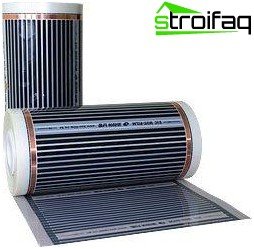
Expanded clay – the most popular and affordable material for insulation, works perfectly in any design, compatible with “warm floor” systems, in particular with infrared film floors
The thermal insulation properties of expanded clay depend on the size of the granules, its bulk density and strength.
Expanded clay fractions are determined by the granule size: 5×10, 10×20 and 20×40 mm. In any of the fractions, 5% of large and smaller granules relative to normalized sizes are allowed.
In bulk density, expanded clay is divided into 10 grades: from the 250th to the 800th. The brand number corresponds to the number of kilograms per cubic meter (brand 350, for example, means that the bulk density of the material is 350 kg / m3). Grains with a lower density are more porous, which means that the thermal insulation properties of the material are higher.
For each brand in terms of bulk density, strength requirements are established. This norm is determined by squeezing granules of various markings in special cylinders. This indicator is important in construction, since it determines the area of optimal use of expanded clay taking into account the load on the structure. For example, to insulate the floor in the bathhouse you will need large expanded clay, and the thermal insulation of the attic or attic can be done in small fractions.
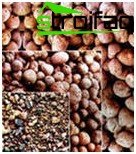
Types of expanded clay in size and structure
Expanded clay happens different types and brands
There are three types of expanded clay:
- gravel, with granules from 5 to 40 mm;
- crushed stone obtained by crushing expanded clay coarse fraction gravel, with various sizes;
- sand, with grain sizes not exceeding 0.5 cm.
Expanded clay sand is used for the production of dry mixes of wide application – for thermal insulation of walls, ceilings, foundations. The compacted sand is lined with parquet floors. Filling with a layer thickness of 10-15 cm allows you to achieve significant savings on heating – heat loss is reduced by 60-70%.
Gravel is an ideal thermal insulation material for floors, ceilings, roofs. It is he who is most suitable for warming the floor of the attic or attic.
Benefits and good reasons for choosing
Compared to other heat-insulating materials, expanded clay has undeniable advantages. Let’s consider them in more detail:
- Expanded clay – a natural material that is made from environmentally friendly natural clay, without harmful additives, which means it is completely harmless to human health.
- The porous structure of expanded clay gives it good heat and sound insulation properties, thanks to which it is used for basement insulation, floors, roofs of buildings, for thermal insulation of utilities.
- Expanded clay expanded material, which significantly reduces construction costs.
- The small size of expanded clay and its flowability allow filling all available voids.
- Resistant to changes in humidity and temperature, and this is important in our climatic conditions.
- Expanded clay is a lightweight material, as a result, the load on the foundation is less, which makes its installation more economical. It is this quality that reduces labor costs and increases the efficiency of construction work.
Expanded clay is produced in the form of gravel, crushed stone and sand. In addition to insulation of floors and attics, expanded clay is also used for thermal insulation of utilities at home.
Expanded clay as a heater for utilities
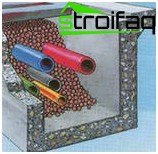
Expanded clay – an amorphous material that provides free access to the damaged section of the pipeline in case of damage
Using expanded clay granules create thermal insulation for utilities, including pipelines. Ceramsite granules mixed with polystyrene crumbs fill the cavity. This option of insulation is more effective than thermal insulation with mineral wool and will help protect water and heat communications from freezing. In addition, expanded clay provides quick access to water and heat networks without destroying them, and the durability of expanded clay allows it to be used again after eliminating the breakthrough.
When erecting a foundation, the use of gravel allows to reduce the depth of its up to 150 cm, since the material covered along the perimeter of the building will prevent freezing of the soil. Material is delivered in bulk on dump trucks or in bags. When purchasing loose expanded clay, it is necessary to take into account the shrinkage coefficient with this method of its delivery. It equals approximately 1.15. The material received in packaged form is easier to calculate: 20 bags are one cubic meter.
In addition, packed expanded clay is more convenient to unload, store, and also move to the place of construction work. True, loose expanded clay is cheaper, but with it more trouble.
Expanded clay floor insulation step by step
- The floor of the room, unlike the walls and ceiling, is under constant load. Therefore, first of all, it is necessary to calculate the thickness of the required backfill layer, and then the future screed, and also plan the expected loads.
- Before applying a layer of expanded clay bedding, it is necessary to take care of waterproofing, which will protect the bedding from possible moisture penetration. For this purpose, high-strength plastic film is most often used. At the joints, the film is glued with ordinary construction adhesive tape to form a single sealed fabric. The substrate is spread around the perimeter of the room so that the edges overlap above the fill layer on the walls, after which the excess part is trimmed.
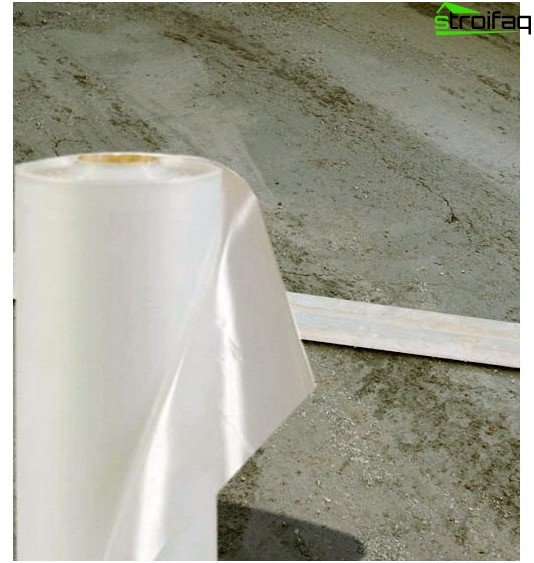
Protecting the floor from moisture with a dense plastic film – waterproofing
- In order to obtain maximum compaction and prevent shrinkage of the floor, it is subsequently recommended to mix different fractions of expanded clay granules (from 5 to 20 mm), which will contribute to better wedging and create stronger adhesion to concrete. This method of falling asleep during the insulation of the floor in the bath is especially important, where, in addition to physical impact, it is also exposed to moisture.
- The next step is to set up beacons that help to perform floor insulation with minimal errors in terms of grade. The first lighthouse is installed a few centimeters from the walls. Subsequent guides are installed parallel to the first beacon, along the length of the rule, which is used to level the screed. Properly exposed beacons will provide a level floor. The lighthouses themselves are usually made of a metal pipe or profile so that they do not bend, but are securely fixed in a specific position. The more lighthouses installed, the better the screed.
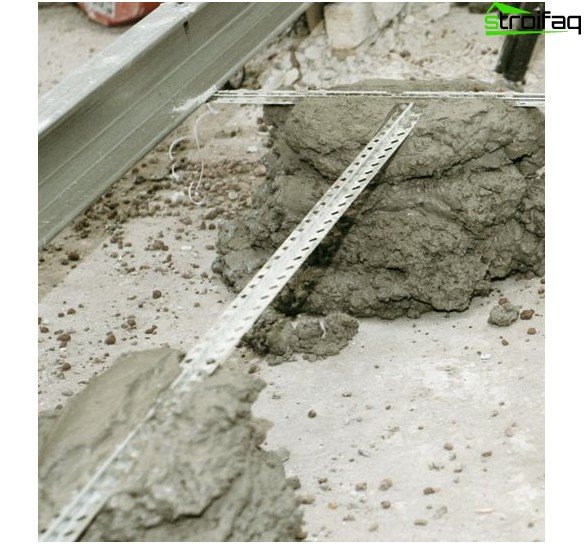
Leveling and reinforcing beacons to ensure a level floor
- The next step is to fix the beacons on heaps of cool cement, alabaster or gypsum mortar. After the guides were carefully aligned using the building level and firmly fixed with the hardened mortar, you can begin to fill the expanded clay with an even layer, slightly compacting it. The level of backfill must be checked, and they do this with a tape measure or a prepared template, measuring the distance from the upper edge of the beacon to the backfill. Irregularities and deviations are not allowed..
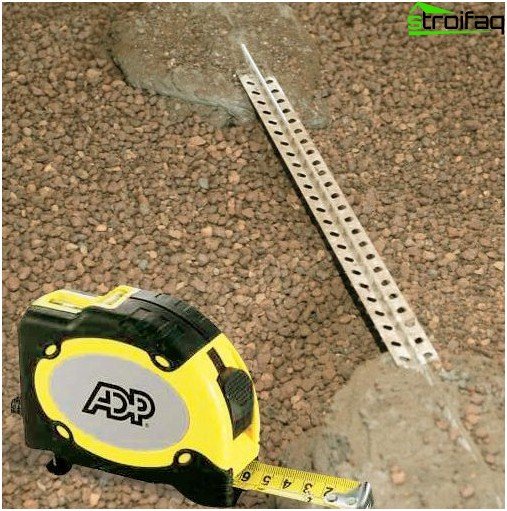
Expanded clay layer leveling with a tape measure
- Then expanded clay should be prepared before pouring the solution. It must be abundantly poured with a liquid solution of cement (“cement milk”). This is done to give initial strength to the insulation layer so that it does not move further when working with a mixture of concrete or cement. Reinforcing the floor with a metal mesh over the entire surface will provide it with additional strength, reducing the risk of coating deformation under load.
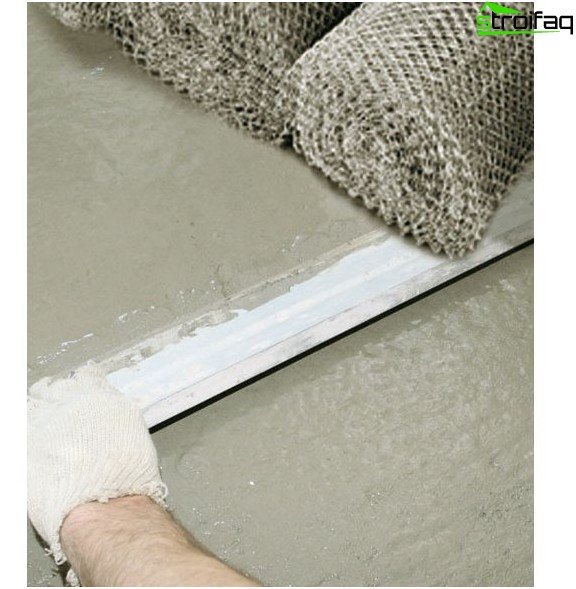
Reinforcement of the floor with metal mesh
- The final stage is filling the floor. The solution is thoroughly mixed to a consistency that can fill in a layer of expanded clay. Filling starts from the wall opposite to the entrance, stretching the solution to the level of the lighthouses. Plot after plot fill the floor around the perimeter of the room.
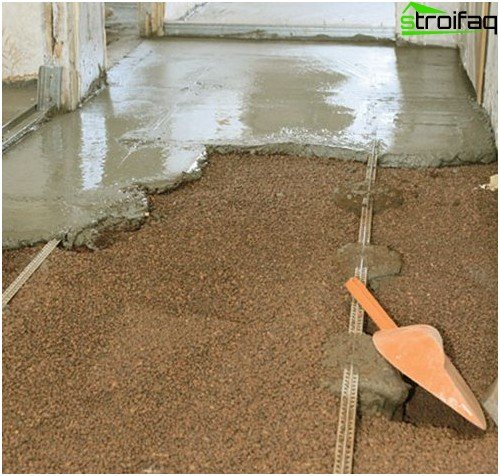
Pouring a layer of expanded clay concrete mortar
Important ! When calculating the thickness of the expanded clay layer, it must be remembered that it begins to manifest itself as thermal insulation, starting with a thickness of 10 cm or more.
It should be remembered that when choosing floor insulation with expanded clay, the optimal coating on top of it is considered wooden.
Walking on the flooded floor is not recommended earlier than a week later. But the process of complete hardening and gaining the final strength of the coating will be completed only in four weeks.
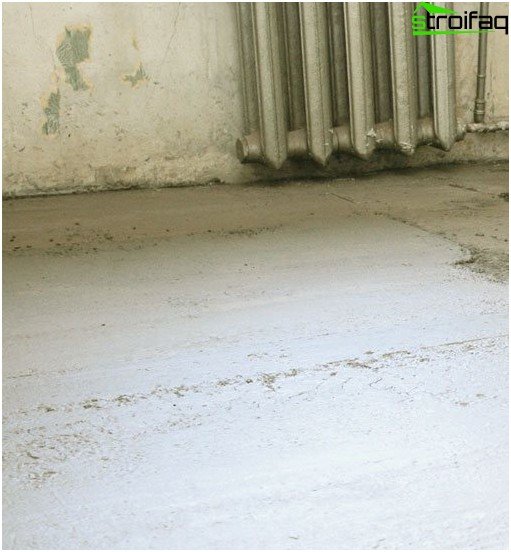
Result: perfectly aligned, excellently insulated floor
During this time, the floor must be moistened periodically with water to prevent cracking. You can check the readiness of the floor using a glass jar, placing it with its neck down. If it fogs up, it will mean that the floor has not yet dried out. Or you can define it by visual inspection of the surface: the shiny and dark floor is still not completely dry, and you cannot use it yet.
The correctly done work described above will allow you to enjoy a quality warm floor for a long time.






